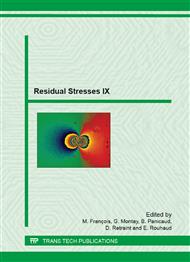[1]
YAO Can-yang. Numerical simulation of quench temperature field and internal stress field of aluminum alloy 7050 thick plate. Changsha: School of Mechanical and Electrical Engineering, Central South University, 2007, pp.14-28.
Google Scholar
[2]
GONG Hai. Research on evolution and evaluation model of residual stress in aluminum alloy thick plate. Changsha: College of Mechanical and Electrical Engineering, Central South University, 2011, pp.18-27.
Google Scholar
[3]
Muammer Koc, John Culp, Taylan Altan. Prediction of residual stresses in quenched aluminum blocks and their reduction through cold working processes. Journal of Materials Processing Technology, 174(2006)342-354.
DOI: 10.1016/j.jmatprotec.2006.02.007
Google Scholar
[4]
S Rasouli Yazdi, D Retraint, J Lu. Study of through-thickness residual stress by numerical and experimental techniques. Journal of strain analysis, 33 (1998) 449-458.
DOI: 10.1243/0309324981513147
Google Scholar
[5]
D. A. Tanner, J. S. Robinson. Residual stress prediction and determination in 7010 aluminum alloy forgings. Experimental Mechanics, 40(2000)75-82.
DOI: 10.1007/bf02327551
Google Scholar
[6]
G. P. Dolan, J. S. Robinson. Residual stress reduction in 7175-T73, 6061-T6 and 2017A-T4 aluminum alloys using quench factor analysis. Journal of materials processing technology, 153-154(2004)346-251.
DOI: 10.1016/j.jmatprotec.2004.04.065
Google Scholar
[7]
Michael B Prime, Michael R Hill. Residual stress, stress relief, and inhomogeneity in aluminum plate. Scripta Materialia, 46(2002)77-82.
DOI: 10.1016/s1359-6462(01)01201-5
Google Scholar
[8]
ZHANG Dan-wen, LIU Hong-zhao, LIU Ping. Evaluation of residual stresses in 7075 aluminum alloy plate using crack compliance method. Transactions of Materials and Heat Treatment, 27(2006)127-131.
Google Scholar
[9]
CHEN Ming-xiang. Elasticity and Plasticity. Science Press, 2010, pp.4-10.
Google Scholar


